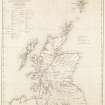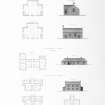Pricing Change
New pricing for orders of material from this site will come into place shortly. Charges for supply of digital images, digitisation on demand, prints and licensing will be altered.
Croick Parish Church
Apotropaic Mark (19th Century), Church (19th Century) (1827), Graffiti(S) (19th Century)
Site Name Croick Parish Church
Classification Apotropaic Mark (19th Century), Church (19th Century) (1827), Graffiti(S) (19th Century)
Alternative Name(s) Croick Church; Croich Church
Canmore ID 12503
Site Number NH49SE 8
NGR NH 45682 91476
Datum OSGB36 - NGR
Permalink http://canmore.org.uk/site/12503
- Council Highland
- Parish Kincardine (Sutherland)
- Former Region Highland
- Former District Sutherland
- Former County Ross And Cromarty
Publication Account (1995)
One of the parliamentary churches designed by Thomas Telford, but better known for its connection with the Clearances, the church shelters in a belt of trees in the empty strath. It is still in use, but the single-storey parliamentary manse just up the road is now a private house.
The harled church is built to the usual T-plan with a small belfry, cast-iron latticed windows and two doors, but with no provision for galleries. It is one of the very few parliamentary churches with its original fittings intact, the pews with a long communion table in front facing the pulpit and the reader's desk, which are flanked by the box pews for the elders and the manse.
One of the best documented Clearances took place here, witnessed by a Times reporter. Already in 1840 a number of families had emigrated from the district to Pictou, Canada, in a ship chartered by their minister, the Rev R Williamson, so that the new minister found 'ruined homesteads and a depopulated parish'. In May 1845 James Gillander, factor to Major Charles Robertson of Kindeace, evicted 18 families from Glencalvie, 92 people in all, to make way for a new sheep farm. Unlike those cleared in Sutherland, they were not given new crofts. Unable to find accommodation despite a desperate search, some 80 people of all ages took refuge in the churchyard at Croick, where they camped in a crude shelter covered with tarpaulins and blankets. Their plight was vividly recounted in a Times report (of which a copy is displayed in the church). Their further history is uncertain, though some at least were settled near Edderton, and others in Ardgay and Shandwick where their descendants now live.
Scratched on the glass of the east window are poignant references to this event: 'Glencalvie people was in the churchyard here May 24th 1845; Glencalvie is a wilderness below sheep' and the like. It seems unlikely that these were written by the evicted people themselves, who spoke only Gaelic as the Times reporter records. A possible candidate is the 'John Ross, shepherd, Croick' whose name appears four times, twice with the date 1869.
Information from ‘Exploring Scotland’s Heritage: The Highlands’, (1995).
Field Visit (9 August 2016 - 11 August 2016)
As part of a graffiti art pilot project undertaken by HES in 2016, a range of graffiti was recorded within the fabric of Croick Parish church. The aim of the project was to record and transcribe the known graffiti that is etched on to the outside of the windows of the church and to record any further instances that were discovered, either on the fabric of the building itself or on any of the furnishings and fittings. The graffiti at Croick provides specific evidence of the eviction of people from their homes in Glencalvie during 1845, and other historic events.
The majority of the graffiti is etched on to the exterior of the east window. Other examples of writing can also be found etched on to the exterior of the south window; on the bible rests, on the backs of the pews and on the precentor’s box. Some of the writing etched on to the east window has been transcribed previously and the following description make use both of those transcriptions and recent photographs (taken as part of this project) to create a full and up-to-date record.
The east window comprises two main parts, each of which contain small diamond-shaped panes of glass. The transcriptions of the individual panes refer to the left-hand frame (from top left to bottom right) and then the right-hand frame, as seen from the outside of the building (see DP248368, which has been reversed). The transcriptions below are cross-referenced with the Canmore photograph reference number.
1. ‘BABS...’ –DP246522
2. ‘John Ross Shepherd Croick May 15 1869’ –DP246519
3. ‘Glencalvie people the wicked generation Glencalvie’ –DP246516
4. ‘Glencalvie tenants residing here’ –DP246514
5. ‘Glencalvie Greenyard murder was in the year 1854 March 31’ –DP246521
6. ‘Ros...James Borthwick...’ –DP246518
7. The Glencalvie tenants reside in the kirkyard here May 24 1845’ –DP246515
8. ‘The Gencalvie amat’ –DP246523
9. ‘John Ross shepherd Croick the Glencalvie people here May 24th 184[5]’ –DP246520
10. ‘John Ross shepherd Croick Ardgay Ross May 1864’ –DP246513
11. ‘This house is needing repair’ –DP246506
12. ‘July 5th 1870’ –DP246504
13. ‘July 1871’ –DP246500
14. ‘... ... Ann Swalesl[??]’ church officer of this place –DP246507
15. ‘Glencalvie is a wilders... Below sheep... that... to the... Croick’ –DP246502
16. ‘Glencal people(e) was in the churchyard here May 24 1845’ –DP246510
17. ‘Croick’ –DP246505
18. ‘May 24 1845’ -DP246501
19. ‘The Glen... peoples were here 1845 the Glencalvie Ross’ –DP246512
20. ‘John Ross 1854... Glen... 24’ –DP246508
21. ‘The Glencalvie tenants resided here May 24 1845’ –DP246503
22. ‘....’ –DP246499
The writing on the pews ranges from names and initials (see DP24630, DP24631). The writing inside the precentor’s box comprises pencil-written names with dates and additional, partially obscured, notes (DP246528). There is also an unfinished hexafoil inscribed into the inside of the precentor’s box (DP246529). Hexafoils are common apotropaic markings, sometimes found in churches and often associated with the north wall or door of the church. In the case of the Croick hexafoil, it is positioned on the north-face of the preceptor’s box where it would have been visible to whoever was sitting in the box, but not to the general congregation.
Visited by HES, Survey and Recording (AGCH, ZB) 9-11 August 2016.
Project
Recording Scotland's graffiti project was designed to review the range of historic and contemporary graffiti art across Scotland. It involved desk-based assessment and fieldwork at a number of example sites, to consider recording methodologies and dissemination practices.
Between 2016 and 2017, phase 1 of the project aimed to:
Aim 1: review a range of historic and contemporary graffiti art from across Scotland, already present in Canmore.
Aim2: undertake a research review of previous approaches to recording graffiti art in Canmore and other HERs, review and develop the current Thesaurus terms.
Aim 3: test and develop a range of recording methods within the following programmes or projects: Discovering the Clyde programme (1223), Scotland’s Urban Past (1222), Architecture and Industry projects, such as Urban Recording Projects (1028), Area Photographic Survey (311) and the Tomintoul and Glenlivet Landscape Partnership (1167).
Aim 4: the following test sites will be considered for research into the range of historic and contemporary graffiti. They will be analysed to demonstrate the different ages, contexts, styles and survivals of historic and contemporary graffiti: Polphail village (Canmore ID 299112), Scalan farmstead (170726), Cowcaddens Subway Station (243099), Croick Parish Church (12503), Dalbeattie Armament Depot (76279) and Dumbarton Rock (43376).
Aim 5: to research the potential for social media to play a role in crowd-sourcing information and archiving Scotland’s graffiti art.
In 2017-2019, phase 2 of the project aimed to:
Aim 1: To enhance the NRHE to the point at which it can be said to adequately represent the broad range of historic and modern graffiti that is evident throughout Scotland, and to explore ways by which that information can best be disseminated.
Aim 2: To develop guidelines that will convey the HES approach to researching and recording graffiti.
Aim 3: To write a specification for a book on Scotland’s graffiti.
Aim 4: To develop external partnerships to explore further ways to record graffiti and to identify and explore potential funding streams to enable further knowledge exchange and research.
The project was managed by Dr Alex Hale, with contributions from staff across Herirtage and Commercial and Tourism directorates.






























![East window. Detail of writing etched on glass. (Image reversed for legibility.) 'John Ross shepherd Croick the Glencalvie people here May 24th 184[5]'](http://i.rcahms.gov.uk/canmore/l/DP00246520.jpg)

































![East window. Detail of writing etched on glass. (Image reversed for legibility.) '... ... Ann Swalesl[??] church officer of this place'](http://i.rcahms.gov.uk/canmore/l/DP00246507.jpg)


































![East window. Detail of writing etched on glass. (Image reversed for legibility.) 'John Ross shepherd Croick the Glencalvie people here May 24th 184[5]'](http://i.rcahms.gov.uk/canmore/s/DP00246520.jpg)

































![East window. Detail of writing etched on glass. (Image reversed for legibility.) '... ... Ann Swalesl[??] church officer of this place'](http://i.rcahms.gov.uk/canmore/s/DP00246507.jpg)










